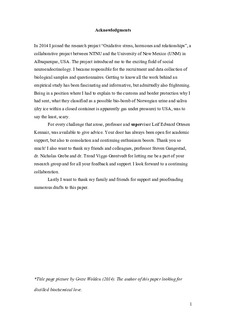Oxytocin and romantic attachments
Master thesis
Permanent lenke
http://hdl.handle.net/11250/2489779Utgivelsesdato
2017Metadata
Vis full innførselSamlinger
- Institutt for psykologi [3103]
Sammendrag
This study assesses how the neuropeptide oxytocin (OT) is distributed in a Norwegian sample and its relationship with adult romantic attachment orientations. Previous research on associations between OT and adult romantic attachment have been equivocal and theoretical models appear openly conflicting. By combining prior empirical research and a novel hypothesis (Identify and Invest), it’s attempted to reconcile diverging data and models to gain a more complete understanding of the oxytocinergic system. OT secretion is here suggested to vary in response to romantic attachment orientations and allocate psychological resources, such as attention, reward sensitivity, or interpretation of cues in the romantic relationship. A sample of 148 romantically involved individuals was analyzed using two different sampling procedures (an OT baseline measure and a controlled lab procedure to measure OT change). Regression analyses suggest that secure romantic attachment orientation is positively associated with OT, and avoidant romantic attachment orientation is negatively associated with OT. This effect was only evident in the total and in the female sample. The OT baseline distributions are positively skewed, as expected from previous OT research on young adults. Surprisingly, the OT baseline and OT change were correlated negatively, which indicate that the oxytocinergic system differs in momentarily reactions and more permanent features. Overall, the results in this paper imply that OT is implicated in regulating important processes of romantic attachment.
